All about small German Spitz
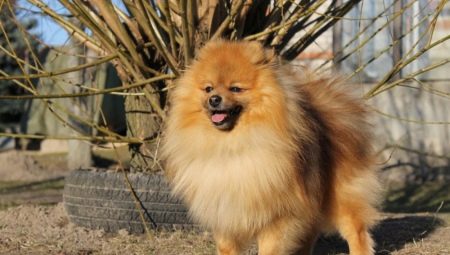
A funny face, fluffy fur and a kind, mischievous character - these are the main advantages of dogs, which will not leave indifferent either children or adults. In our article, we will focus on the features of dogs of the Small German Spitz breed, the intricacies of caring for them, the content and type of feeding.
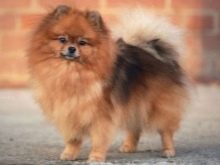
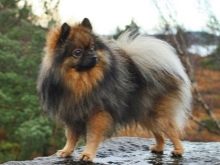
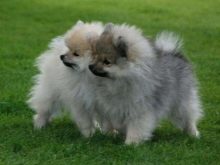
Description
The German Spitz is one of the oldest dog breeds. Her remains were discovered during excavations in Sweden and dated to the 10th century BC. NS. It is believed that her distant ancestors were peat dogs.that looked exactly like the large Spitz, better known as the Wolfspitz. However, in addition to large dogs, small breeds were also bred in Germany; they were first introduced in the 18th century and almost immediately won the hearts of thousands of breeders with their charming appearance. Monarchs, court ladies, gentlemen and other secular personalities showed interest in these miniature dogs. Little Spitz gradually migrated from Germany to other European countries.
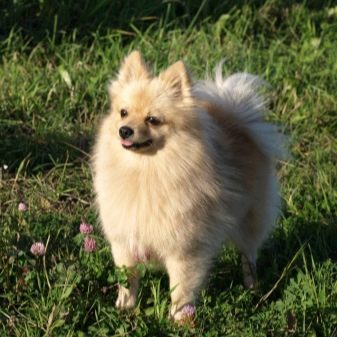

Today, the small Spitz, or, as it is also called, the Kleinspitz, in accordance with the accepted and officially approved standards, should have a mass of 3-6 kg and a height at the withers of 22-28 cm.Thus, if two-month-old puppies weigh about 3.5 kg and have a height of 23 cm, then in front of you is a typical small Pomeranian, and weight is not considered the main standard for the classification of these dogs - the standardization is based on height.
An important factor when evaluating a dog at a show is the quality of the coat. As a rule, it is of medium length with a rather thick, almost wadded undercoat.The guard hair itself is straight and rather tough, therefore, caring for such a coat does not present any problems - it is not prone to tangling and tends to repel dirt and moisture from itself. The entire head, with the exception of the muzzle, is covered with this hair, including the area near the ears; a collar is pronounced on the chest. The rest of the body, in addition to the areas of the elbow folds, is also covered with dense, stuffed fur.
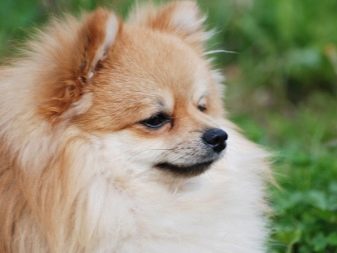
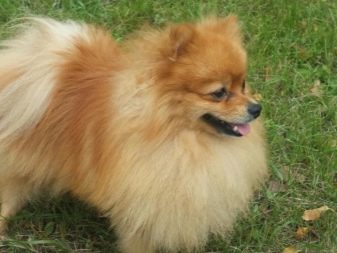
The color of dogs of this breed can be very different:
- from light sand to beige;
- tanned;
- with bluish tints;
- Gray;
- light chocolate;
- ginger;
- brown.
Dogs can be one- and two-tone. All representatives of the small German Spitz have a sharp muzzle resembling a fox, small erect ears and black eyes. The Spitz is characterized by a raised tail, bent into a ring so that it fits snugly against the back. The body landing is square or straight.
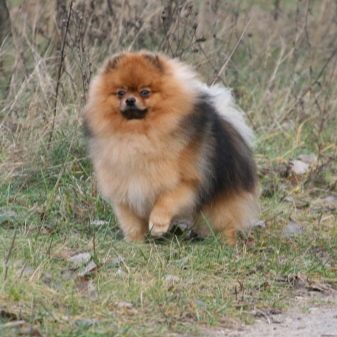
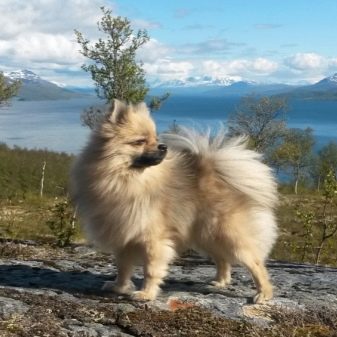
Advantages and disadvantages of the breed
The undoubted advantage of the dog is its mischievous appearance, thanks to which it evokes the warmest feelings. Small size makes the pet truly versatile - you can hold the dog in your arms and enter even those rooms where access with animals is prohibited. An important advantage of dogs of this breed is a very sharp mind, which greatly simplifies training.
Dogs literally on the fly grasp all the commands and in the shortest possible time learn a variety of tricks, which is why small Spitz are especially popular when staging circus acts.

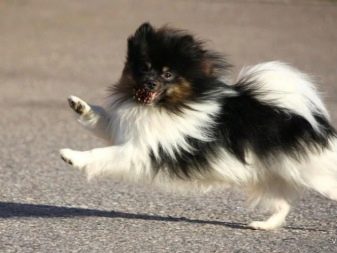
At the same time, pets are very sensitive dogs, they have a fine mental organization, only restrained and affectionate treatment is allowed with them. Angry and irritable people cannot become good owners for such a Pomeranian, since they remember even the slightest offense. Building a relationship with a dog that has been yelled at and beaten at will not be easy.
Another plus of small Pomeranians is their devoted disposition, so such a pet can become ideal companions for both a lonely person and a large family. The pet is friendly towards schoolchildren, and the annoying attention and sometimes negligent attitude of babies may not like the dog, and it will begin to show aggression.
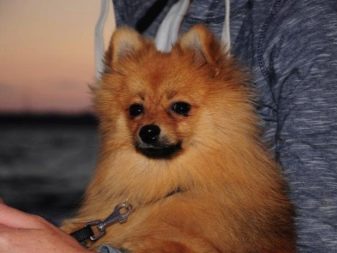
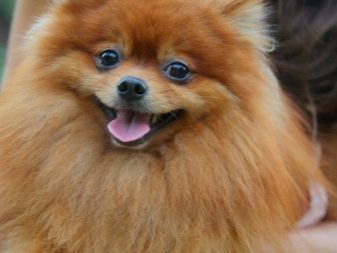
This is not to say that Spitz coexists well with other pets. Of course, they cannot harm cats or other dogs, but they are quite capable of causing conflicts. Being extreme owners, they will not tolerate the "division" of the owner by other animals, they can start a violent showdown even with larger dogs. Small Spitz are active dogs; they are unlikely to be suitable for elderly people, whose walks are reduced to rest on a bench.
When walking this animal, active games are assumed, and the shorter the walk, the more load the dog should receive.
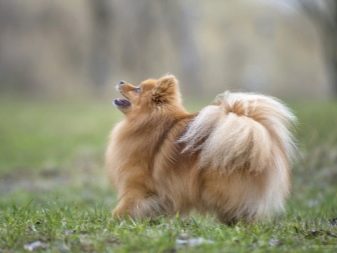
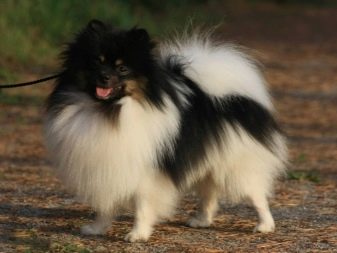
How many years do they live?
Small Spitz can be safely attributed to long-livers - the life expectancy of these indoor decorative pets with good care is up to 15 years. However, in pursuit of decorativeness, two new dwarf breeds have recently been introduced: the puppet and bear spitz, these dogs are in great demand, as they resemble a plush toy, but, unfortunately, they do not meet any accepted standards and have very poor health.
So, a flattened, too shortened muzzle in practice makes it difficult for dogs to breathe and thereby weakens the pet's cardiovascular and nervous system.


However, the standard small spitz is susceptible to some diseases. Among the most common are:
- dysplasia of the hip joint;
- common problems when changing teeth - usually milk teeth have to be removed;
- tendency to increased lacrimation and suppuration of the eyes;
- collapse of the trachea.
It should not be forgotten that despite their miniature size, dogs are real gluttons, and if you do not control food intake, they are quite capable of eating non-stop, and this often leads to heart problems, blood vessels and joints of animals.
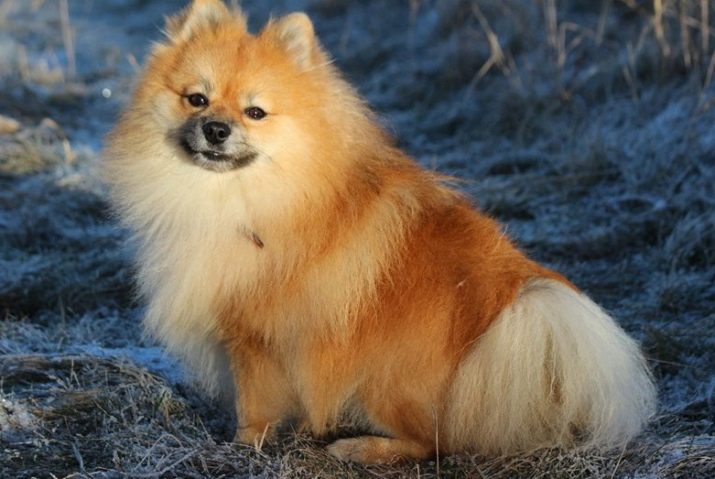
Character traits
The peculiarity of this cute little dog is the ability to command its owners and always get what it wants, it is not for nothing that with its whole appearance this animal so resembles a cunning chanterelle, which can always beg for what it needs, whether it be the caress of the owner or a piece of an appetizing delicacy. The Spitz is capable of asking, swearing, dodging and even demanding. This manner is not always to the liking of breeders and sometimes gives them very unpleasant emotions.
Therefore, from the first days of a pet's stay in the house, you need to resist all of its tricks and make it clear that no - this means a final refusal. Rest assured that dogs learn these lessons very quickly and stop begging. In all other respects, the Pomeranian is simply ideal, and if you can raise him correctly, problems with such a pet will no longer arise, and minor cons will fade into the background.
Although in fairness, we note that it is very difficult to refuse such pussies, so the owners most often begin to indulge them and thus make a rather big mistake.
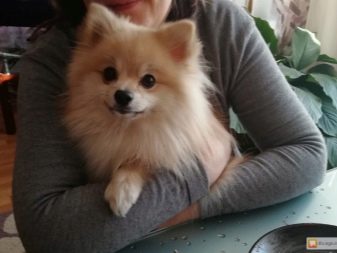
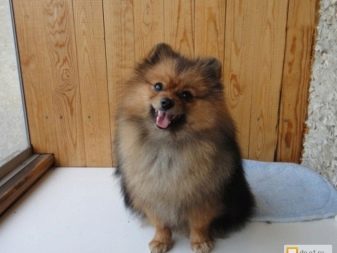
The Little Spitz is sincerely interested in all the actions of its owner, and no matter what he does, he tries to be there. However, sometimes he can find more interesting activities - for example, having fun with his favorite toy or spending time with small children. Well, in what, but in playfulness this dog simply has no equal. Some Pomeranians are very successful in coping with the tasks of a guard - their loud barking can scare anyone away, however, dogs have a frightening effect only in those cases when they are not visible. But if you want to have a truly watchdog, it is better to give preference to the large Spitz.

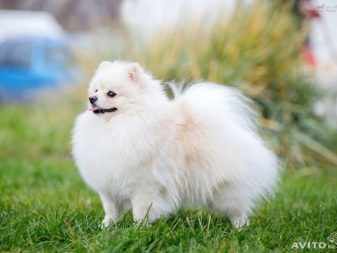
How to choose?
When choosing a puppy, it should be borne in mind that as the dog grows up, its color may change, and the color is fully revealed only by the age of 3 years. Breeders who have bought black and white dogs will have the hardest part - already in the second month of life, a dark coat may brighten, and a light coat, on the contrary, may become darker or reddish. Considering that puppies are bought at an earlier age, it is better to focus not on the color of the trails, but on the pigmentation of the mucous membranes. So, if a dog has black lips and eyelids, it means that the animal will retain its dark color.
When buying white puppies, you can navigate by the ears - if the fur growing behind them has a brown tint, then as the dog grows, the fur coat will change its shade to cream or beige.
It should be noted that light-colored Spitz are considered the most expensive variety of the breed, this is due not only to external attractiveness, but also to the difficulty of breeding. The fact is that if you cross two light-colored dogs, you get too large puppies, so breeders breed white and beige dogs, from litter to litter, "lightening" their fur.

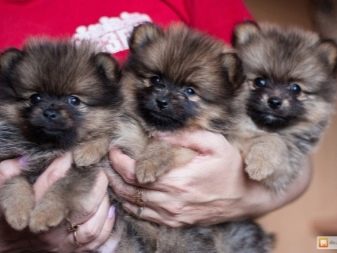
How and what to feed?
There are several principles to follow when feeding small German Spitz. The dog should always have free access to drinking water. In comfortable conditions under normal health, an adult dog weighing 2.5 kg drinks up to 50 ml of liquid per day, if we are talking about small puppies or lactating females, then this indicator needs to be increased. Spitz need a regular, varied diet. The trough should be in the same place and fill at the same time.
Feeding should be dosed. So, dogs weighing 2.5-3 kg per day need 75-85 g of food, if the animal is obese or was overfed in the last meal, then the dose is reduced by 40-50 g. If the animal leads an active lifestyle and participates in tricks , then the dose, on the contrary, is increased to 100-120 g.Nutrition should be balanced - up to 70% of the diet should be proteins of animal origin, they are obtained from high quality meat and by-products. In addition, low-fat cottage cheese can become another source of protein; it is recommended to include it in the menu 2-3 times a week. All other nutrients, including carbohydrates, vitamins and minerals, are obtained by pets from vegetables and cereals.
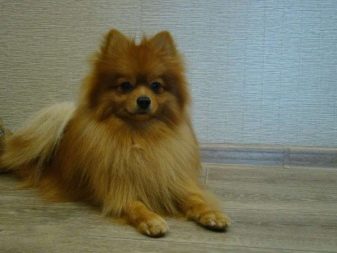
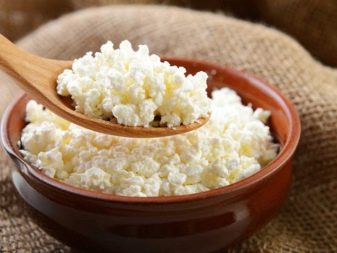
Do not give your dogs salted, canned, spicy and fried foods. You should not introduce store-bought sausages and sausages into the diet. As a rule, they contain preservatives and flavor enhancers, which is fraught with the most unpleasant consequences for the pet's gastrointestinal tract. If desired, you can use ready-made feed, preference should be given to expensive premium and super-premium products, which have a balanced composition and contain only natural ingredients of the highest quality.
The food offered to the pet must be biologically safe, that is, fresh. To avoid the ingress of dangerous microorganisms into the dog's body, you should wash the feeders and drinkers after each meal, store the prepared food in a cool dry place and, of course, refuse to use products that are in doubt.
When feeding your pet, you should keep its weight and physical activity under control, adjusting the diet as necessary.
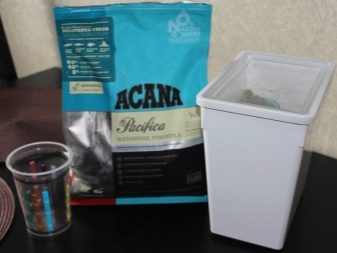

How to care?
Small Spitz are truly miniature lap dogs that love comfort and therefore feel much better in an apartment than in an aviary. The main problem comes down to grooming the coat - it must be combed every day (at least 2 times a month) and trimmed periodically. It is best to entrust the haircut of your beloved pet to professionals., but if you have some grooming skills, you can walk on the pet's coat yourself, but only with scissors.
The use of clippers is unacceptable, since in this case the undercoat can be affected, and it grows very slowly in Spitz, its violation can spoil the quality of the coat as a whole for a long time.
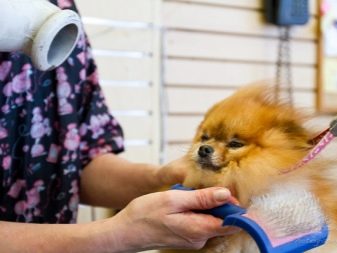
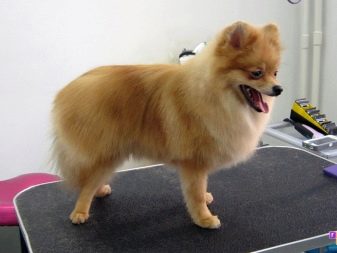
See the video about the small German spitz below.






































